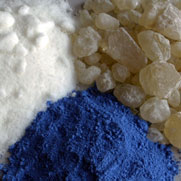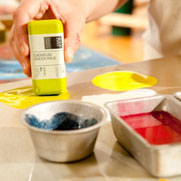
Encaustic
|
exerpted from R&F Handmade Paints
|
For product questions or availability talk to our knowledgeable sales team! We carry a wide range of Encaustic products and will be adding more to our website.
DENVER: 303.698.3838 | 800.950.ARTS [2787] COLORADO SPRINGS: 719.578.8070 or Ask Us Anything>

 What is Encaustic Paint?
What is Encaustic Paint? Encaustic painting was practiced by Greek artists as far back as the 5th century B.C. Most of our knowledge of this early use comes from the Roman historian Pliny the Elder whose Natural History, written in the 1st century A.D. was a monumental encyclopedia of art and science. Pliny seems to have had little direct knowledge about studio methods, so his account of techniques and materials is not thorough, but his discussion gives us an idea of its general usage. According to Pliny, encaustic had a variety of applications: for the painting of portraits and scenes of mythology on panels, for the coloring of marble and terra cotta, and for work on ivory (probably the tinting of incised lines).
Encaustic painting was practiced by Greek artists as far back as the 5th century B.C. Most of our knowledge of this early use comes from the Roman historian Pliny the Elder whose Natural History, written in the 1st century A.D. was a monumental encyclopedia of art and science. Pliny seems to have had little direct knowledge about studio methods, so his account of techniques and materials is not thorough, but his discussion gives us an idea of its general usage. According to Pliny, encaustic had a variety of applications: for the painting of portraits and scenes of mythology on panels, for the coloring of marble and terra cotta, and for work on ivory (probably the tinting of incised lines). Painting with encaustic is a multi-step process. First, the paint must be melted, or liquefied. Next, the molten paint is applied to a porous surface. Then the applied wax is reheated, or fused into, the working surface, allowing it to form a good bond. As a final option, the cooled paint can be buffed to bring up the luster of the wax and resin.
Painting with encaustic is a multi-step process. First, the paint must be melted, or liquefied. Next, the molten paint is applied to a porous surface. Then the applied wax is reheated, or fused into, the working surface, allowing it to form a good bond. As a final option, the cooled paint can be buffed to bring up the luster of the wax and resin.